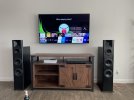The ones I've heard have been very nice sounding, but do seem to lack a certain bite or sharpness (compared to a waveguided metal dome, for instance). They don't quite seem to convey the reality of sound to the same extent, seems a bit too good, if you know what I mean.
What are your thoughts on AMTs?
What are your thoughts on AMTs?
Last edited:
